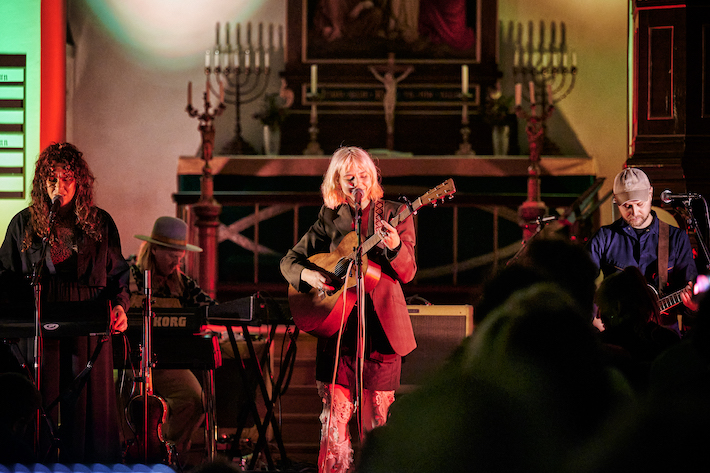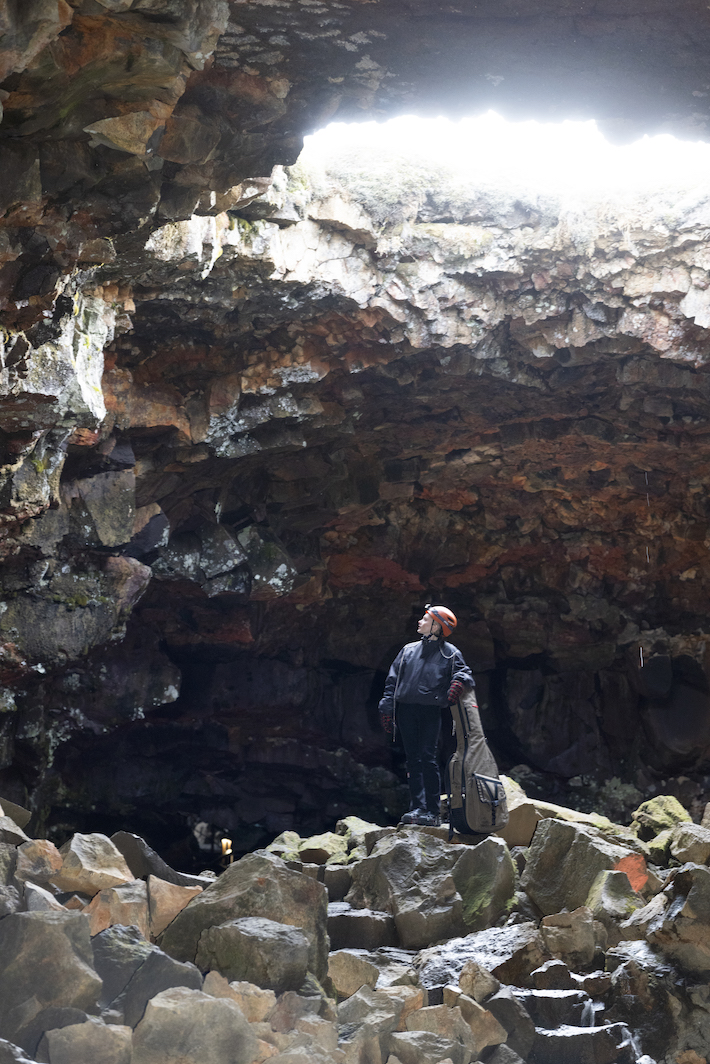
For a country whose entire population is roughly half that of a midsize American city like Dayton, Ohio, there’s a surprising amount of music within Iceland’s borders. Sure, there are big names like Björk and Sigur Rós, but in recent years, the country has produced a two-time Grammy Award-winning composer (Hildur Guðnadóttir), a chart-topping folk rock band (Of Monsters And Men), and a Eurovision Song Contest finalist (Daði Freyr). While the country’s stunning, mossy pastoral landscapes and breathtaking waterfalls offer endless creative inspiration, Reykjavík’s annual music festival Iceland Airwaves gives insight into why the country has so many creatives making waves globally.
Reykjavík is a city that’s no stranger to tourism. At any given time, one-third of the people in Reykjavík are international travelers keen to get a glimpse of the Northern Lights or take a dip in one of the city’s hangover-curing geothermal pools. But for one weekend every November, the city prioritizes a different kind of tourism: Music tourism. Iceland Airwaves, which took place the weekend of November 2nd through 4th 2023, invited over 100 musicians from around the world to take over the city’s downtown venues.
Those who have visited SXSW in Austin would be familiar with Iceland Airwaves’ setup. Rather than cramming thousands of attendees into a stadium or filling up a local park with a few stages, Iceland Airwaves is sprawled across the city in a handful of different venues of all shapes and sizes. That way, attendees are able to experience the city, its culture, and its music in a unique way.
All of Iceland Airwaves’ scheduled performances take place after sunset, opening attendees up to playing tourist in the daytime. Before shifting into festival mode, I was able to peruse the shops (and gawk at the price of authentic Icelandic wool sweaters) in Reykjavík’s Rainbow Street shopping district. I stopped by the picturesque church Hallgrímskirkja and climbed its tower to see stunning 360-degree views of the quaint city before picking up the best cinnamon roll of my life at Braud & Co (I promise TikTok influencers are not overhyping this one), and warmed myself up after a day of meandering with a traditional Icelandic lobster bisque.
While I made music discovery a prime objective of the weekend, catching a few of my favorite North American artists in an Icelandic setting was a highlight. Indie darlings Blondshell brought their early aughts-inspired sound to a sizeable crowd at Reykjavík’s art museum, Andy Shauf delivered a stripped-down version of his latest album Norm and some of his early fan favorites to dedicated listeners at an opera house, Ghostly Kisses performed their haunting tunes to an intimate show at a lit-up church, and Anjimile closed out a packed hostel living room with their arresting tunes.
My personal music tastes had me prioritizing sets by indie artists, but the Icelandic musicians I caught made it clear there’s not just one genre of music the country specializes in. I saw everyone from the industrial electro-house trio Ex.Girls, which had an entire crowd dancing even after a long day, alt-rock group Tilbury, which sounded like they could have headlined Shaky Knees Festival, and singer-songwriter Nanna (of Of Monsters And Men fame) who brought a crowd to tears with her moving melodies. I even got the chance to see folk songwriter Elín Hall deliver a breathtaking acoustic set inside the Raufarhólshellir lava tunnel.

Though they might not share a genre, the real throughline of Icelandic artists is how the country uplifts them. As Reykjavík mayor Dagur Bergþóruson Eggertsson put it at a welcome party, “Music gave Reykjavík the confidence to stand up and be who we are.” It’s a way for Icelanders to “find their voice, even if it’s not in the mainstream.” It’s clear the city puts an emphasis on the arts, whether it’s the countless murals you see walking throughout the city, the feature-length Icelandic films screening in their theaters, or the fact that a country with a relatively small population produces such a wide variety of musicians. Iceland has a dedicated music export office, which helps their artists earn grants and put them on the map globally. They even incentivize artists to record music in their country through a program aptly called Record In Iceland, which uses funding from the State Treasury to reimburse 25 percent of the recording costs for music incurred in Iceland.
Like most festivals, getting there is the hard part. Thankfully, Icelandair teams up with the festival each year to offer packages that include flights, festival passes, and airport transportation, so the “getting there” portion of the trip is actually pretty seamless. Unlike most festivals, though, there are no lengthy security lines to get in, and you won’t find yourself queuing up to use a Porta Potty that hasn’t been cleaned in three days (In fact, there wasn’t a single Porta Potty in sight). The venues are clustered around Reykjavík’s city center, allowing for natural crowd control that results in shows actually feeling intimate. One moment, I was seated in the pews of Fríkirkjan, a 124-year-old church adorned with fading frescos that transformed the concert into a spiritual experience. Then, a short walk had me seated at a show at the ornate opera house Gamla Bíó.
The downside of the spaced-out venues is that it’s easy to find yourself on a 20-minute trek back and forth if set times put your favorite artists at opposite ends of the city center (and when it’s 30 degrees outside with icy wind that gives Chicago a run for its money, this Los Angeles resident felt like she was in an arctic spinoff of Survivor). Another tip for future Iceland Airwaves travelers: Plan your arrival several days before the music starts. I took a red-eye flight that had me touching down in Reykjavík the day the music started, which meant I was so jet lagged I had to miss a handful of performances I was really looking forward to.
One weekend and many fish and chips meals later, I boarded my flight back to the US inspired by the stunning natural surroundings I witnessed, the kind people I met, and the moving music I heard. Overall, Iceland Airwaves is the perfect festival for adventurous travelers who want to discover new music and culture in a unique way. It pulls back the curtain on how a country is able to foster such a wide variety of music and the arts and offers a chance to witness performances you’d never be able to see stateside.
Uproxx was hosted by Iceland Airwaves for this story. However, they did not review or approve this story. You can read our press trip/hosting policy here.


 68
68